
Perennials are one of the most versatile groups of plants that can be used in the garden. Other than the range of colours in many assorted types of flowers, many perennials can be grown just for their foliage effect.
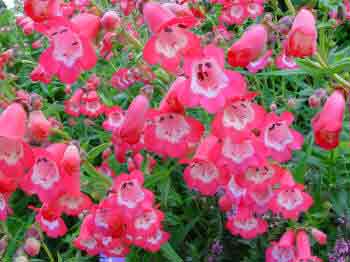
Pink Penstemon flowers
Most of the Perennials used in the garden are hardy perennials - even if they die down each year. They will be back the following year - more robust and with more flowers! That is why they are known as 'Herbaceous Perennials'.
Perennials have the widest range of foliage effects, so suited to all types of garden situations. They are economic - lasting for many years - often for the price of a single bedding plant, such as a geranium - or even a petunia.
You do not have to be put of with visions of huge perennial borders. Even the smallest of gardens can be home to a multitude of assorted perennial plants.
There are perennials for Sunny Positions - Dark Corners; Dry Banks - Boggy ground; Foliage features - Floral Display; Spring - Summer; Autumn - Winter; Tall Specimens - Low Ground Cover; Cut Flowers - Dried Flowers; Garden borders - Patio Containers. The lists simply go on and on. Such is the Versatility of Hardy Herbaceous Perennials.
Whilst there is nothing quite like the majestic swathe of colours and form to be seen in many of the large herbaceous perennial borders of large gardens and stately homes, there is absolutely no reason why perennials should not form the basis of successful and colourful gardening. Mix perennials with shrubs, add a few bedding plants and bulb and you have the gardening utopia - so often sought , but rarely realised - colour and interest for twelve months of the year!
All manner of of plants are used these days in 'mixed borders' - including shrubs, bulbous plants, herbaceous perennials, and even some of the tender exotic plants. The shrubs, bulbous plants and the perennials will give interest and satisfaction for years.
Historically, gardens were almost always 'perennial' with no access to the wide range of bedding plants now available. Perennials include bulbs and shrubs, but there are dedicated areas of the website to deal with those plants.
The versatility of herbaceous perennials is soon appreciated when trying to draw up a list of plants for given situations. Problem situations even!
We hope to have one of the largest and most informative databases of perennial plants for the uk, and have started working to that end.
The writer has first hand working knowledge of many perennials, together with which he has spent many hours (years?) of his life photographing them. His photos have been and still are being used in newspapers, magazines, books and scientific tracts.
The rockery starts to become a rock garden with the planting of rock plants - almost all of which will be hardy perennials. These will range from the ubiquitous Aubrietia and Golden Alyssum, to the more choice rock garden plants which are the true 'Alpines'.
Many of the plants found in the traditional - or modern - herb garden are also perennials - some are Evergreen Perennials, such as the Thymes and Sages. Others happily partaking in the herbaceous habit of growth, and therefore dying down each winter - to re-appear the following year. Mint and Fennel fall into this category - as does Angelica.
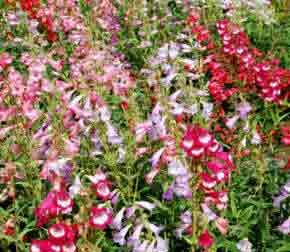
Penstemons
Basically, the definition of a perennial, is a plant that lives for more than two years. If the plant has a natural life cycle of only two years, then it is a biennial. If it lives for just one year or less, then it is an annual.
If you buy a plant for your garden that is labelled as a perennial, and you fail to look after it properly, and it dies after a few months, it is still a perennial. But, it is now a dead perennial!
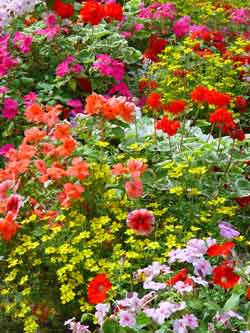
Bedding Plants
Before comparing the advantages and disadvantages of either perennial plants or annuals – a basic gardening definition of perennial plant
A perennial is a garden flowering garden plant that lives for more than one year – often 4 or 5 years; sometimes longer. Perennial flowers are normally herbaceous, but can also be evergreen.
An annual garden plant is one which is grown from seed, flowers and then dies; all in the same year. Annual flowers are normally sown in the spring to grow; bloom; and set seed in the summer and autumn and then die immediately after seeding.
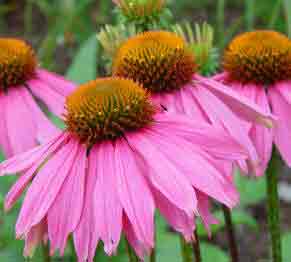
Echinacea
The best time for planting perennials is normally in the autumn or early spring, but as with all plants for the garden now, they can be bought all the year round as potted plants, and so can be planted at any time of the year.
Perennials planted in late spring and summer, will need a little bit of extra care to ensure that they establish properly. In particular, they will need regular watering to allow their root system to establish into the surrounding soil.
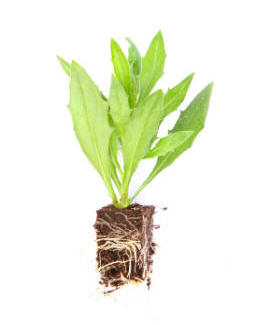
Soft Wood Cuttings
Once you have herbaceous perennial plants, it is quite a simple matter to increase them – either by division, layering, root cuttings, and stem cuttings.
Propagating herbaceous Perennials can be carried out in various ways - all of them quite easy.
If there is a problem with propagating your own perennials, it is simply that it is so easy to do, that you will probably end up with more young plants than you can use!
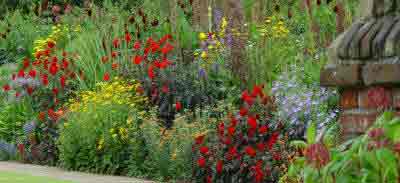
Perennials
Why divide perennials – When to divide perennials and How to divide perennials.
Many people are put off the idea of perennial gardening because of the supposed need to dig up and divide your perennials each year, so let's put the record straight about this.
First and foremost is the fact that most perennials do not actually NEED to be divided each year. Many perennials are happy to go through their entire life, without the discomfort of being dug up each damp, cold autumn and cut into chunks then re planted. It is us – the gardeners – that NEED to divide the perennials – generally for aesthetic or propagation reasons.
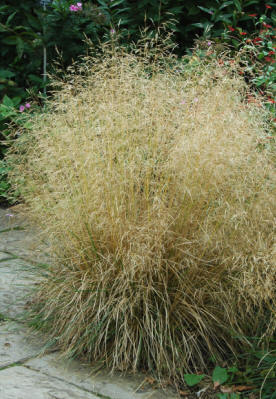
Deschampsia C. Goldtau
A Perennial Plant is one that lives for several - maybe many - years. Shrubs, trees, bulbs, and some garden plants are all true perennials. Many houseplants will also fall into this category - even though 'tender' perennials.
An Evergreen Plant is one that retains leaves throughout its life - even if it sheds some of its leaves from time to time. Again, some shrubs, some trees and some garden plants are evergreen plants.
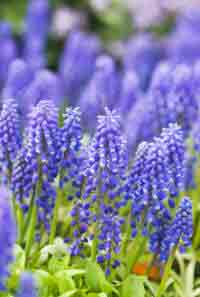
Grape Hyacinths
Alphabetical listing of Perennials with links to individual pages and plants.
In this listing of perennial plants, we include the perennial grasses, bulbs and even sum vegetables which are both perennial and ornamental. Needless to say it also includes hardy ferns
Perennials Starting with A - Linked pages include Ajuga; Agapanthus; Achillea; Alchemilla; Alliums; Anemone; Anetheum - (Dill); Asparagus - Wulfenia, Xanthocerus, Xerophyllum, Zantedeschia, Zauschneria

Helenium Rubinswerg
Perennials are plants that will normally live for a long time – several or many years. Some perennials die down to ground level each autumn/winter and start to re-grow the following spring. Those that die down and re sprout are known as Herbaceous Plants. They normally increase in size each year, because they will be re-starting life with a larger root system left over from the previous year. Other Perennials do not die down each year, and they are known as evergreen perennials . Trees and shrubs are typical examples!
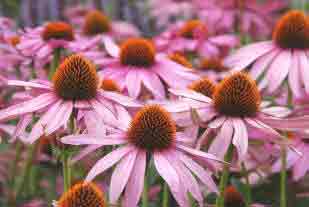
Echinacea Purpureus
Big gardens used to have big herbaceous borders. Small gardens do not normally have herbaceous borders. It is a shame, for a herbaceous border can be as small as any space where you can plant a hand full of plants.
A true herbaceous plant, is one where the foliage and stems die down to ground level in the late autumn (sometimes summer) and then grows back again the next year.
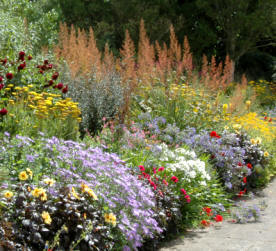
Mixed Perennial Border
You will probably already have an idea of where you want your herbaceous border or bed to be in your garden. A light sunny aspect is best, but dappled shaded areas can also be used with the choice of the right herbaceous plants.
Herbaceous beds and borders tend to be better in informal shapes rather than straight lines. This is mainly because of the wide range of shapes, sizes and flowering periods of perennial plants are more suited to informal shapes rather than formal shapes.

Astilbe
Weeds can become a problem in new and established herbaceous perennial borders. They are difficult to remove or control once they get a firm hold in your border, so, prevention is the key action to prevent a build-up of weeds in perennial beds and borders.
Regular hoeing between the perennial plants is always a good way to prevent a build-up of weeds, but take care not to damage any underground shoots of your perennials. If hoeing in the dormant season, it is easy to cut off the emerging shoots of your plants accidentally.
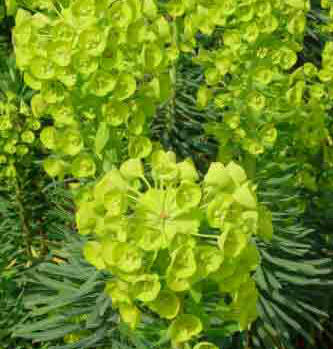
Euphorbia
The Euphorbia group of plants - as well as having several shrubs included and even annuals - is an invaluable group for the perennial garden.
Many Euphorbias are evergreen, and therefore give colour or interest through much of the year. Some are semi evergreen whilst others are deciduous or rather herbaceous perennials - which is to say that they die down to ground level during the winter and re-grow again in the Spring.